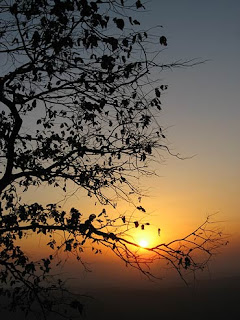Surrounded by the northern fringe of the Vindhyan ranges, Bhimbetka lies 46 km South of Bhopal. In this rocky terrain of dense forest and craggy cliffs, over 600 rock shelters belonging to the Neolithic age were recently discovered.
In fact, the place has witnessed a cultural sequence right from the late stone age to the early historic period. The flamboyant paintings that depict the living styles of primeval mankind are definitely a treasure house of information and a precious narrative in the history of man. As the name itself suggests, this historic place is closely related to the legendary figure Bhim, the second in the Pandavas. The popular belief is that, it was here that Bhim took a brief rest during his exile. The word Bimbetka literally means Bim’s lounge.
The paintings found at Bhimbetka Caves, MP are about 10000 years old. A five or six thousand years old skeleton was also unearthed during the excavation of this site.
It is also said that Pandavas, during theie exile stopped here and made this place their home for some time.
Above: This is the largest cave at Bhimbetka. This is believed to be the assembly hall of the community that lived here and the leader addressed the group from that rock at the end of the hall. All formations here are natural. From the state of the rocks found here, it is thought that this whole area must have been under water for a while.
A marvel in the archaeological perspective, Bimbetka is adorned with the accolade of being the richest depository of prehistoric paintings, in South Asia. It is the twenty second place in India, which is declared as a World heritage site by UNESCO. The Rock Shelters at Bhimbetka exhibit the earliest traces of human life in India. Archeologists are of the opinion that these caves might have been occupied over 10,000 years ago.

Various community activities, like birth, burial, dancing, religious rites, hunting scenes, animal fighting and merrymaking, find a place in these paintings. Pictures of animals like rhinoceros, tigers, wild buffalo, bears, antelopes, boars, lions, elephants, lizards etc also find intense depiction. It is quite a marvel that the colors of the paintings at Bhimbetka have skillfully avoided the vagaries of time. Natural red and white pigments are common colors used in these paintings. Often green and yellow are also used.
The colors are a combination of manganese, hematite, wooden coal, soft red stone, plant leaves and animal fats. These chemicals have, over the time, reacted with the rocks and contributed in preserving these precious artworks of Bhimbetka. Scrupulous observation shows differences in patterns, which are archetypal of various periods. Huge linear figures of animals are the trademark of Paleolithic paintings. With the passage of time, paintings became smaller, precise and more delicate.



















